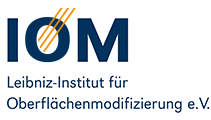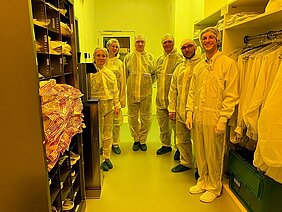In a joint project funded by the BMBF and the GRAVOmer network, researchers from the IOM research area "Reactive Ion Beam Assisted Structuring and Smoothing", together with Carl ZEISS Jena GmbH and scia Systems GmbH, want to establish novel ion beam-based manufacturing processes with which inclined surface profiles (blaze profiles) for diffractive optical elements (DOE) can be realised that are not accessible with previous technologies. To this end, a new ion beam etching technology for the production of monolithic, blazed silicon diffraction gratings for beamline applications in the VUV, EUV and X-ray range is to be developed on the basis of lithographic structure definition. In particular, if successful, enormous performance increases can be realised through more sharply defined blaze edges, especially against the background of constantly decreasing blaze angles.
Blazed diffraction gratings, also known as echelette gratings, are reflection gratings with an asymmetrical, triangular groove profile that is optimised to maximise diffraction efficiency for a particular diffraction order. According to the current state of the art, these special optical gratings can be produced using holography/interference lithography on transparent fused silica substrates (high-purity quartz glass) by exposure to counter-rotating waves. The resulting blaze profiles in the photoresist are then transferred to the fused silica substrate by reactive ion beam etching (RIBE). However, this process is not applicable to silicon substrates (which are not transparent at the required exposure wavelengths). However, the latter are indispensable for a number of beamline applications due to their excellent thermal conductivity in order to efficiently dissipate the high radiation power introduced into the cooling medium. Mechanically split ("scribed") gratings on silicon are therefore currently used for high-performance beamline applications. The blaze grooves are scribed sequentially directly into a mostly metallic graduation layer using a (usually) diamond needle. The metallic grating profile is then transferred to the Si substrate using RIBE.
However, the increasing demands on the resolution of blazed gratings for beamline applications are becoming more and more difficult to achieve with "classic" mechanically split gratings. In addition, there are generally only a few grating machines worldwide that enable the typically required qualities, i.e. ideal blaze profiles for maximising diffraction efficiency, so that there is an almost monopolistic market situation.
With the successful development of the novel ion beam-based manufacturing processes planned in the project, the technological limits of beamline gratings with regard to wavefront and diffraction efficiency can be decisively shifted, as they enable the use of binary lithography processes that have been further developed (especially with regard to wavefront errors), such as electron beam lithography or interference lithography, whereby blaze generation takes place in a subsequent etching step. This opens up completely new design possibilities, e.g. in the production of optical coupling gratings for data glasses applications, but also in other areas of photonics (e.g. biosensor technology). In addition, the project expands the number of possible manufacturers of beamline gratings and thus the market environment and general manufacturing capacities.

